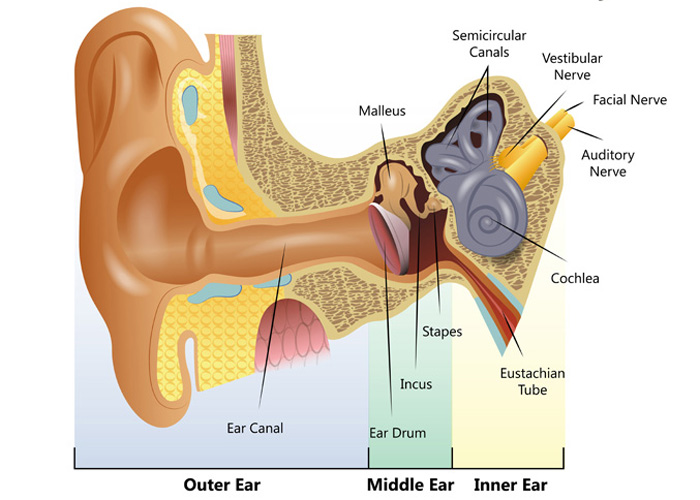
Your ears consist of three different areas, known as the outer ear, the middle ear, and the inner ear. Each part works together to enable you to hear sounds.
The Outer Ear
The outer ear is made up of the pinna, which is the flesh part you can see on the side of your head, and the ear canal, the route along which sound travels. The outer ear ends at the eardrum, a layer that divides the outer and middle ear.
The Middle Ear
The middle ear is filled with air and consists of the three smallest bones in your body, called the malleus, the incus, and the stapes. These bones form a sequence called the ossicles, and act as the link through which sound passes from the middle ear to the inner ear. The middle ear also contains the eustachian tube, which is connected to your nose and throat, and performs the function of ventilating the middle ear.
The Inner Ear
The inner ear has two parts:
The Cochlea:
The cochlea is a curled tube and acts as the hearing part of the inner ear. It contains an outer and inner chamber, both of which are filled with liquid. Within the inner chamber is the organ of corti, which contains thousands of hair cells, of which each one has minute formations called stereocilia. It also contains the auditory nerve, which sends signals to your brain.
The Semicircular Canals:
The semicircular canals are an element of your balance system, and are not used for hearing. As with the cochlea they are filled with liquid and contain hair cells. The semicircular canals work to send information to your brain about the direction your head is moving.
How you hear
When a sound is made it vibrates the air around it and creates what is known as sound waves.
The outer ear gathers the sound waves, which then move along the ear canal and are transmitted to the eardrum. This in turn causes the eardrum to vibrate.
This vibration is then passed on to the ossicles, the three smallest bones in the body, which increase the sound and send it through to the inner ear.
This causes the stereocilia within the cochlea to move, generating an electrical signal that is passed along the auditory nerve to the brain.
The brain is then able to interpret the signal and convert it into meaningful information such as language.
